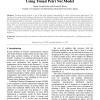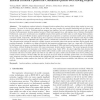175 search results - page 2 / 35 » One Update for all Moving Objects at a Timestamp |
IS
2006
13 years 5 months ago
2006
Given two sets S1, S2 of moving objects, a future timestamp tq, and a distance threshold d, a spatio-temporal join retrieves all pairs of objects that are within distance d at tq....
IAJIT
2010
13 years 3 months ago
2010
: Tracking moving objects is one of the most common requirements for many location-based applications. The location of a moving object changes continuously but the database locatio...
DEBU
2002
13 years 4 months ago
2002
Current moving-object indexing concentrates on point-objects capable of continuous movement in one-, two-, and three-dimensional Euclidean spaces, and most approaches are based on...
JCST
2010
12 years 11 months ago
2010
Abstract The significant overhead related to frequent location updates from moving objects often results in poor performance. As most of the location updates do not affect the quer...
JSS
2006
13 years 4 months ago
2006
Tracking of mobile objects trajectories is one of many modern applications supported by Spatiotemporal databases. Within the context of this application, queries about the present...


